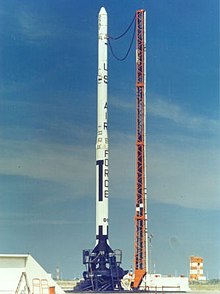 Blue Scout II rocket | |
| Function | Expendable launch system Sounding rocket |
|---|---|
| Manufacturer | Vought |
| Country of origin | United States |
| Size | |
| Height | 24 metres (79 ft) |
| Diameter | 1.02 metres (3 ft 4 in) |
| Mass | 16,874 kilograms (37,201 lb) |
| Stages | Four |
| Capacity | |
| Payload to LEO | |
| Mass | 30 kilograms (66 lb) |
| Associated rockets | |
| Family | Scout |
| Launch history | |
| Status | Retired |
| Launch sites | Canaveral LC-18B |
| Total launches | 3 |
| Success(es) | 2 |
| Failure(s) | 1 |
| First flight | 1961-03-03 |
| Last flight | 1961-11-01 |
| First stage – Algol 1B | |
| Powered by | 1 solid |
| Maximum thrust | 471 kilonewtons (106,000 lbf) |
| Specific impulse | 236 sec |
| Burn time | 40 seconds |
| Propellant | Solid |
| Second stage – Castor 2 | |
| Powered by | 1 TX-354-3 |
| Maximum thrust | 286 kilonewtons (64,000 lbf) |
| Specific impulse | 247 sec |
| Burn time | 27 seconds |
| Propellant | Solid |
| Third stage – Antares 1A | |
| Powered by | 1 X-254 |
| Maximum thrust | 60 kilonewtons (13,000 lbf) |
| Specific impulse | 256 sec |
| Burn time | 39 seconds |
| Propellant | Solid |
| Fourth stage – Altair 1A | |
| Powered by | 1 X-248A |
| Maximum thrust | 14 kilonewtons (3,100 lbf) |
| Specific impulse | 255 sec |
| Burn time | 40 seconds |
| Propellant | Solid |
The RM-90 Blue Scout II was an American sounding rocket and expendable launch system which was flown three times during 1961.[1][2][3] It was a member of the Scout family of rockets.[4] Blue Scout II was a military version of the NASA-operated Scout X-1, with adjustments to the payload fairings, engine nozzles and fins.[1][3]
Blue Scout II had a total length of 21.65 m and a finspan of 2.84 m.
It was capable of sending a 30 kg payload to a 300 km orbit at 28.00 degrees.[1] It was a four stage vehicle, with the following engines:[1][2][3][5]
- Stage 1: Algol 1B, solid propellant;
- Stage 2: Castor 2 (TX-354-3), solid propellant;
- Stage 3: Antares 1A (Star 31/X-254), solid propellant;
- Stage 4: Altair 1A (X-248), solid propellant.
Blue Scout II was used for two HETS test flights, and the launch of the Mercury-Scout 1 satellite for NASA.[1][2][6] This rocket and RM-89 Blue Scout I were replaced by Blue Scout Junior.[3]
- ^ a b c d e Mark, Mark. "Blue Scout II". Encyclopedia Astronautica. Retrieved 2024-09-28.
- ^ a b c Gunter, Krebs. "Blue Scout-2". Gunter's Space Page. Retrieved 2024-09-28.
- ^ a b c d Parsch, Andreas (2003). "Ford RM-90 Blue Scout II". Directory of U.S. Military Rockets and Missiles - Appendix 1: Early Missiles and Drones. Retrieved 2024-09-28.
- ^ Krebs, Gunter. "Scout (Algol-1, -2 based)". Gunter's Space Page. Retrieved 2024-09-28.
- ^ "Antares 1A". www.astronautix.com. Retrieved 2024-09-28.
- ^ "Mercury-Scout 1 (MS 1, MNTV 1)". Gunter's Space Page. Retrieved 2024-09-28.